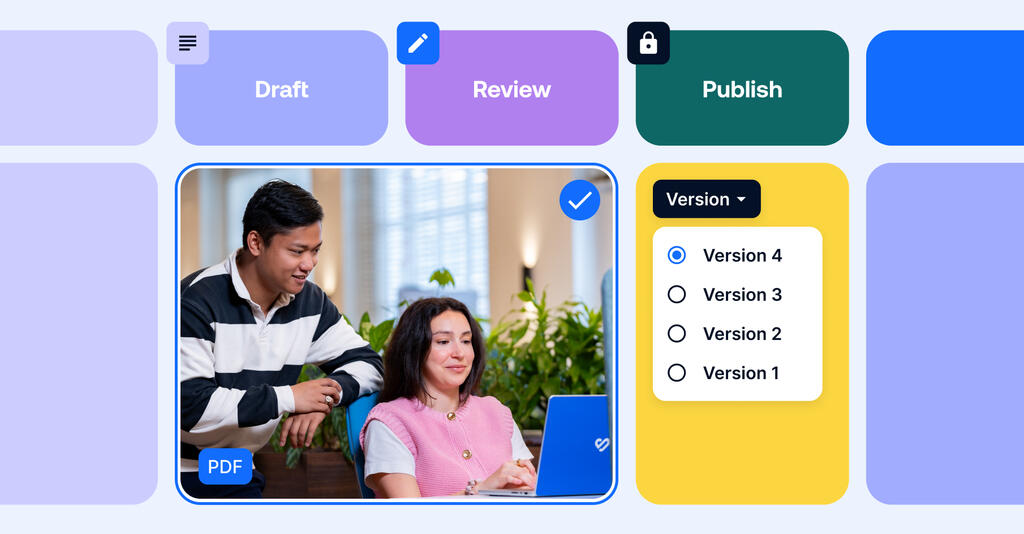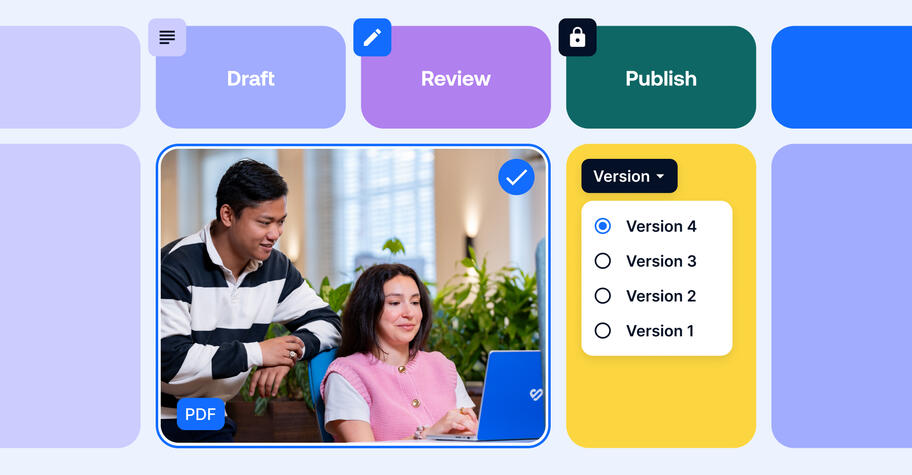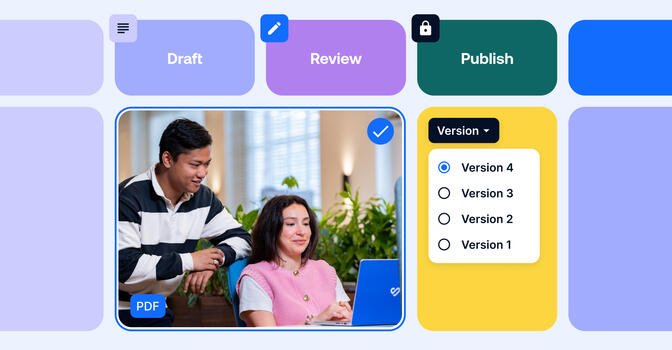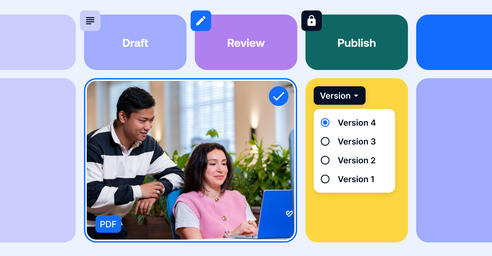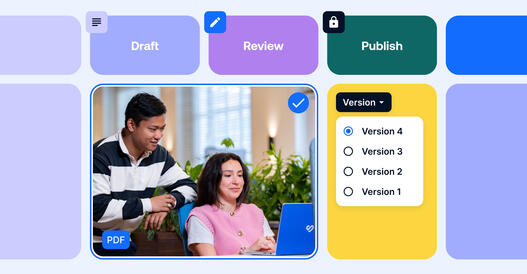Whether your business is a global corporation or a national enterprise, one thing’s for sure: you’ll own a huge amount of digital content. And it’s no longer practical to store physical files, or let employees manage files on their local hard drives. Your employees need to be able to collaborate on and share files across different devices, geographies, and time zones.
That’s where enterprise content management software (ECM) comes into play. In this blog, we’ll explore what an enterprise content management system is, examine five of the best vendors for ECM software, and provide some tips on what to look for when choosing a vendor.
What is enterprise content management?
Enterprises face the continuous challenge of needing to create vast amounts of content to support multiple brands and campaigns. But without an optimized, cohesive approach to content management, they risk significant delays in getting content to market as well as a hindered ability to scale up content production quickly when the business is ready to grow.
All of this costs enterprises and their teams valuable time and money.
ECM is a dynamic, digital-first framework for organizing and controlling unstructured content across an enterprise organization. It brings together smart strategies and scalable tools to help capture, manage, store, and deliver content efficiently.
Furthermore, ECM ensures that enterprise teams can access the right information at the right time, while powering collaboration, quicker go-to-market times, and business growth.
How does enterprise content management work in many organizations?
In many enterprises, content management is anything but smooth. Teams often rely on disconnected tools, email threads, outdated file-sharing systems, and manual workflows to manage creative assets. It means that content lives in silos on local drives and across different teams, which leads to versioning issues, duplication of effort, and a general lack of visibility when it comes to understanding exactly which assets should be used.
Even when an enterprise organization has a legacy digital asset management (DAM) solution in place, the reality is that those platforms were typically designed for simpler content management needs, and therefore, it’s unable to adapt to the scale, speed, and omnichannel demands needed today. Teams often revert to using manual workarounds, even if those solutions end up creating more friction than efficiency.
Without a system of record for their digital assets – one which is flexible, intuitive, and scalable – enterprises face slow content production cycles, workflow bottlenecks, and missed opportunities to go to market faster.
One solution to this challenge is enterprise content management software, which provides a central hub for enterprises to store, organize, update, share, and distribute their branded digital assets.
What is an ECM system?
Enterprise content management software is a system through which large organizations can store and manage basic digital files in a single, centralized location.
ECM systems generally focus on storing formats like:
- MS Office files: DOCX, XLSX, PPTX, etc.
- PDFs: Contracts, paystubs, employee tax documents, etc.
- Emails
- Data and codes
Usually, this kind of software has a basic hierarchical structure that users manually navigate to locate files. Alternatively, users can rely on metadata as the basis of their asset searches.
And while some ECM enterprise management systems also offer the ability to search documents based on words or phrases found in the file, that’s where the range of search options available typically ends.
Importantly, compared to DAM systems, ECM software is far less equipped to manage rich media assets like images, video, audio files, and this ultimately hinders enterprises when it comes to storing all of their files in one place.
In fact, a DAM like Bynder can offer a significant number of additional benefits compared to an enterprise content management system, including the inherent ability to integrate with a whole suite of the most popular CMS and PIM platforms, along with many other kinds of martech that enterprises typically use.
The 5 best ECM tools for enterprises
No matter whether you’re an industrial manufacturer, a B2C brand, or an organization offering professional services; whatever your enterprise offers, you’ll find our take on the five best ECM tool vendors in the marketplace today, below.
Bynder
While many enterprise content management systems aim to manage document files and assets efficiently, Bynder stands out not only because it fulfils ECM requirements, but it redefines and greatly expands on what content management can achieve for enterprises in what is currently a fast-moving, brand-driven world.
At its core, Bynder offers the structured governance, access control, and content lifecycle management expected from a modern ECM system, with the ability to support everything from securely storing digital assets to facilitating enterprise-wide distribution. But where Bynder greatly surpasses an enterprise content management system is how it extends these foundations into a best-in-class, AI-powered DAM solution.
Bynder features go far beyond traditional ECM, empowering users to:
- Optimize rich media assets directly within the DAM;
- Integrate with 130+ leading martech platforms;
- Leverage a robust suite of AI-powered solutions;
- Drive true collaboration across global teams.
Ultimately, this enables brands to unlock the full value of their digital assets, reducing their costs through asset reuse and time savings, accelerating file discovery and content production workflows, and driving stronger competitive advantage, sales, and revenue growth.
And, with a strong focus on AI-led DAM innovation rather than, for example, pure content management, Bynder can provide deeper AI-powered support for users when it comes to supporting asset governance, encouraging asset reuse, and driving brand activation; especially for enterprises that seek true agility, faster go-to-market times, and scalability in their content operations.
Adobe Experience Manager (AEM)
Built as part of the Adobe Experience Cloud, AEM delivers a centralized platform for managing structured content, rich media, and digital experiences across omnichannel. From an ECM perspective, AEM includes many typical features like version control, workflows, and audit trails.
While AEM’s features are designed to support large-scale asset libraries and enable personalized content delivery at scale, its functionality is closely coupled with Adobe’s broader Experience Cloud ecosystem, which can introduce complexity, a higher implementation overhead, and a longer journey when it comes to delivering ROI; particularly for organizations that don’t rely heavily on Adobe’s other products.
While AEM is widely adopted, it can be seen as less flexible and more resource-intensive than alternatives like Bynder.
In contrast, Bynder offers a best-of-breed solution that outperforms AEM in several areas central to digital asset management. These include faster deployment timelines, a more intuitive user interface, stronger out-of-the-box AI functionality, and greater ease of integration with third-party tools outside the Adobe ecosystem.
Aprimo
Aprimo offers an enterprise content management approach grounded in its origins as a marketing resource management (MRM) platform (with DAM capabilities added through acquisition).
The platform includes features typical of an ECM system, such as version control, structured metadata, permission management, and audit trails, while also introducing DAM-oriented enhancements like AI-driven tagging and dynamic asset transformation.
Aprimo may be an acceptable choice for organizations that want to prioritize integrated marketing workflows and centralized content oversight, but it may be unable to fully support complex enterprise scenarios; particularly in terms of its DAM-specific capabilities, its limited range of integrations, and a user interface that can feel unintuitive.
As such, Bynder remains a stronger choice for enterprises that have demanding and complicated digital content ecosystems.
Frontify
Frontify’s offering is led by its ‘brand management’ capability, with software primarily suited to small and mid-market businesses rather than enterprise. It also lacks the ability to fully support organizations looking to scale up their content production as they grow and expand into new markets or regions.
With the emphasis being mainly on brand management and brand guidelines, the scope of how you can manage, locate, and utilize digital assets on Frontify is limited when compared to Bynder.
For example, Frontify offers auto-tagging and also metadata-driven search, while Bynder provides users with automated tagging, advanced metadata search that includes rich media assets and documents, and AI-powered search options like Face Recognition, Natural Language Search, and Text-in-Image Search.
In addition, Frontify’s AI features are limited compared to Bynder. Bynder can offer users access to in-built AI-enhanced content creation tools, including, for example, the ability to generate translations for content localization.
The same can be said for the number and diversity of integration options Bynder offers in comparison to Frontify.
OpenText
OpenText is a legacy leader in ECM, offering solutions for document management, compliance, and workflow automation. It can store rich media assets, provide brand portals, and global asset delivery. And while OpenText has some AI capabilities (such as AI-assisted tagging via OpenText Aviator), it has been noted for having limited AI features compared to other market players.
OpenText is part of a larger, suite-based ecosystem. As a result, integrations often require substantial configuration, take longer to implement because it’s not cloud-based, and can mean that there’s a steeper learning curve for its users. Existing proprietary integrations can also make it a less attractive choice for some.
In comparison, Bynder is well-suited for agile, media-driven enterprise teams that need advanced asset management capabilities without the burden of a full ECM suite.
How to choose enterprise content management software
When evaluating enterprise content management software, it's essential to look beyond their ‘document storage’ capabilities.
While most ECM platforms will provide centralized repositories, version control, workflows, and compliance features for Microsoft Office files and PDFs, many fall short when it comes to managing rich media assets like videos, images, and design files.
Modern enterprises heavily driven by content, brand, and marketing performance therefore, need to identify whether a vendor’s platform can truly meet their ever-evolving content needs.
Here are some key criteria to consider when assessing ECM vendors:
- Content format flexibility: Can the system manage more than just documents like PDFs and Word files? If your enterprise relies on rich media like videos, images, and design files, you’ll need a platform that can handle all asset types natively.
- Search and metadata functionality: Look for AI-powered search capabilities, auto-tagging, and customizable metadata structures. These capabilities dramatically impact how quickly users can find, reuse, and manage assets — especially at enterprise scale.
- Collaboration and workflow: Does the platform support real-time collaboration, versioning, and approval workflows across teams and departments? Keep in mind that creative and marketing workflows require more than just ‘check-in/check-out’ functionality.
- Supporting business growth: If your enterprise is looking to scale up and expand into new markets and global regions, it’s definitely worth selecting a DAM solution over an ECM system for the simple reason that a DAM can scale, whereas an ECM probably can’t meet those needs to the same extent, or as easily.
- Integrations and the general ‘fit’ with your enterprise: Can the vendor’s ECM software integrate easily with your existing tools, including your CMS, the creative suite your teams use, and your productivity apps? The right platform should serve as a content hub, not a silo.
- Governance, permissions, and brand consistency: Beyond basic access control, assess how the platform supports content governance, rights management, asset expiry, and brand consistency. This is particularly important for decentralized or multi-brand enterprise organizations.
Bynder meets and exceeds the above criteria by combining the structured control of ECM with the rich functionality and features of a best-of-breed, AI-powered DAM.
Rather than just keeping pace with ECM expectations, Bynder has set new product standards in the industry when it comes to content agility, brand consistency, and enterprise-wide engagement, with the in-built ability to scale up alongside any enterprise’s growing content demands.
